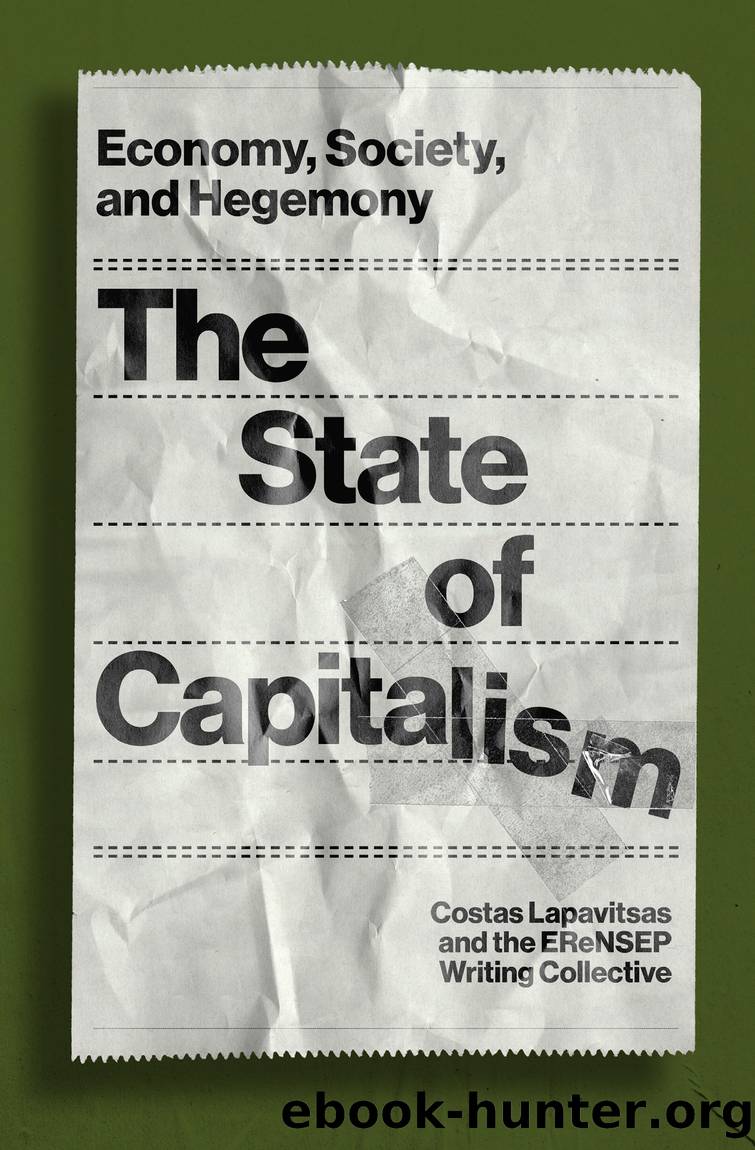The State of Capitalism by Costas Lapavitsas & The EReNSEP Writing Collective

Author:Costas Lapavitsas & The EReNSEP Writing Collective
Language: eng
Format: epub
Publisher: Verso Books
Digital world money?
Digital technologies have given rise to new forms of money that have already become prevalent in the sphere of domestic circulation of core countries and increasingly of peripheral countries. Two of these forms of digital money (or e-money), namely âaccess e-moneyâ and âe-money properâ, have already been analysed in political economy and pose few theoretical difficulties.76
Access e-money is simply the electronic (digital) form of credit money (credit and debit cards, credit transfers, direct debits, etc.). It presents no problems for economic analysis, since it is simply the liability of the issuer that returns when assets mature. Access e-money reflects merely the continuing shift of credit money away from paper and toward an incorporeal form.
In contrast, e-money proper, although still the liability of the issuer, is not created through the advance of credit. Rather, it is privately issued money stored on electronic devices and purchased with ordinary money at par value. Some examples are âprepaid cards, or prepaid software programmes used on the internet, often called server-based e-moneyâ.77 These forms of money are frequently issued by industrial and commercial enterprises; of note among these are mobile telephony providers, which have risen to the fore in peripheral countries in recent years, facilitating monetary transactions locally or even nationally.
For the purposes of world money, however, neither of these digital forms of money is of great consequence. The development that matters is the emergence of cryptocurrencies, yet another digital form of money.
Cryptocurrencies are not liabilities of an issuer created through the advance of credit and returning to the issuer when loans mature and are repaid â they are not credit money. They are also not liabilities of an issuer bought at par by using regular money â they are not e-money proper. Instead, they are potential digital commodity monies.
Cryptocurrencies are properly considered as digital assets (peculiar commodities). To be sure, they lack corporeality but there is a huge range of non-digital commodities which also lack corporeality, such as services. A haircut is as incorporeal as a website â both lack a physical body. However, cryptocurrencies are certainly material, if one properly understands the digital world to be a physical entity, rather than a metaphysical, mental, or even spiritual universe.78 Put differently, the âcyberspaceâ is a material reality of computers, cables, energy, specialist technicians, and users that are subject to the restrictions of matter. Its material reality includes thousands of kilometres of submarine cables, and cryptocurrencies are a product of it.79
In this light, the digital process that underpins cryptocurrencies, i.e. distributed ledger technology (DLT), is a software that functions as a database creating a digital double-entry bookkeeping system. For our purposes, the most appropriate form briefly to consider is a distributed ledger system that is based on a blockchain and is freely open to participants (âpermissionlessâ). Such a system would be programmed as a chain of blocks among nodes (each node being, for instance, a transactor). If a node initiated new data, a predefined algorithmic method would validate the data additions, creating a new block and adding it to the digital ledger.
Download
This site does not store any files on its server. We only index and link to content provided by other sites. Please contact the content providers to delete copyright contents if any and email us, we'll remove relevant links or contents immediately.
International Integration of the Brazilian Economy by Elias C. Grivoyannis(91256)
The Radium Girls by Kate Moore(11921)
Turbulence by E. J. Noyes(7936)
Nudge - Improving Decisions about Health, Wealth, and Happiness by Thaler Sunstein(7615)
The Black Swan by Nassim Nicholas Taleb(7010)
Rich Dad Poor Dad by Robert T. Kiyosaki(6403)
Pioneering Portfolio Management by David F. Swensen(6226)
Man-made Catastrophes and Risk Information Concealment by Dmitry Chernov & Didier Sornette(5921)
Zero to One by Peter Thiel(5686)
Secrecy World by Jake Bernstein(4646)
Millionaire: The Philanderer, Gambler, and Duelist Who Invented Modern Finance by Janet Gleeson(4376)
The Age of Surveillance Capitalism by Shoshana Zuboff(4210)
Skin in the Game by Nassim Nicholas Taleb(4162)
Bullshit Jobs by David Graeber(4095)
The Money Culture by Michael Lewis(4076)
Skin in the Game: Hidden Asymmetries in Daily Life by Nassim Nicholas Taleb(3929)
The Dhandho Investor by Mohnish Pabrai(3699)
The Wisdom of Finance by Mihir Desai(3654)
Blockchain Basics by Daniel Drescher(3507)
